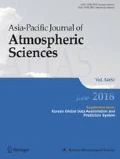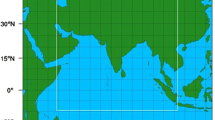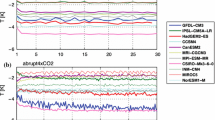Abstract
Sensitivity of the Weather Research and Forecasting (WRF) model simulation of the East Asian summer monsoon (EASM) in 1993 to solar radiation parameterizations and ozone absorption was investigated. Three numerical experiments were conducted using the National Centers for Environmental Prediction/Department of Energy (NCEP/DOE) and the European Centre for Medium-Range Weather Forecasts (ECMWF) reanalysis data as time-varying surface and lateral boundary forcings, respectively: (a) a control run (“CTL”) with the Dudhia radiation scheme and the model top placed at 50 hPa, (b) the “SWG” experiment which is the same as the CTL except the Goddard radiation scheme, and (3) the “SWT” run which is the same as the SWG but the model top was raised to 5 hPa and the vertical levels increased from 31 to 35. The use of the Goddard scheme results in considerable improvement in reproducing the model’s thermal structures, such as zonal mean air temperature, its latitudinal gradient and vertically integrated temperature. This leads to better agreements in the simulation of the upper tropospheric zonal winds through the thermal wind relationship which, in turn, rectifies the lowlevel circulations through dynamical coupling between the upper and lower troposphere. The Taylor diagram analysis quantitatively indicates that the SWT and the SWG are discernable from each other with slightly improved simulations in the SWT. This suggests a nontrivial role of ozone absorption and accompanied stratospheric heating in EASM simulation.
Similar content being viewed by others
References
Adler, R. F., and Coauthors, 2003: The Version 2 Global Precipitation Climatology Project (GPCP) monthly precipitation analysis (1979-present). J. Hydrometeorol., 4, 1147–1167.
Blackmon, M. L., J. M. Wallace, N.-C. Lau, and S. L. Mullen, 1977: An observational study of the Northern Hemisphere wintertime circulation. J. Atmos. Sci., 34, 1040–1053.
Chen, F., and J. Dudhia, 2001: Coupling an advanced land-surface/hydrology model with the Penn State/NCAR MM5 modeling system. Part I: Model description and implementation. Mon. Wea. Rev., 129, 569–585.
Chou, M.-D., and M. J. Suarez, 1999: A shortwave radiation parameterization for atmospheric studies. NASA Tech. Memo., 15(104606), 40 pp.
Davis, C. A., K. W. Manning, R. E. Carbone, S. B. Trier, and J. D. Tuttle, 2003: Coherence of warm season continental rainfall in numerical weather prediction model. Mon. Wea. Rev., 131, 2667–2679.
Ding, Y.-H., 1992: Summer monsoon rainfall in China. J. Meteor. Soc. Japan., 70(1B), 373–396.
Dudhia, J., 1989: Numerical study of convection observed during the winter monsoon experiment using a mesoscale two-dimensional model. J. Atmos. Sci., 46, 3077–3107.
Dyer, A. J., and B. B. Hicks, 1970: Flux-gradient relationships in the constant flux layer. Quart. J. Roy. Meteor. Soc., 96, 715–721.
Fortuin, A. P. F., and H. Kelder, 1998: An ozone climatology based on ozonesonde and satellite measurements. J. Geophys. Res., 103, 31, 706–31, 734.
Fu, Q., and K. N. Liou, 1992: On the correlated k-distribution method for the radiative transfer in nonhomogeneous atmospheres. J. Atmos. Sci., 49, 2139–2156.
Giorgi, F, and L. O. Mearns, 1999: Introduction to special section: Regional climate modeling revisited. J. Geophys. Res., 104, 6335–6352.
Goswami, B. N., and P. K. Xavier, 2005: ENSO control on the south Asian monsoon through the length of the rainy season. Geophys. Res. Lett., 32, L18717, doi:10.1029/2005GL023216.
He, H., C.-H. Sui, M. J. Jian, Z. Wen, and G. Lan, 2003: The evolution of tropical temperature field and its relationship with onset of Asian summer monsoon. J. Meteor. Soc. Japan., 81, 1201–1223.
Hong, S.-Y., Y. Noh, and J. Dudhia, 2006: A new vertical diffusion package with an explicit treatment of entrainment processes. Mon. Wea. Rev., 134, 2318–2341.
Iacono, M. J., E. J. Mlawer, S. A. Clough, and J.-J. Morcrette, 2000: Impact of an improved longwave radiation model, RRTM, on the energy budget and thermodynamic properties of the NCAR community climate model, CCM3. J. Geophys. Res., 105(D11), 14, 873–14, 890, doi:10.1029/2000JD900091.
Janjić, Z. I., 1994: The step-mountain Eta coordinate model: Further developments of the convection, viscous sublayer, and turbulence closure schemes. Mon. Wea. Rev., 122, 927–945.
Kanamitsu, M., W. Ebisuzaki, J. Woollen, S.-K. Yang, J. J. Hnilo, M. Fiorino, and G. L. Potter, 2002: NCEP-DOE AMIP-II Reanalysis (R-2). Bull. Amer. Meteor. Soc., 83, 1631–1643.
Kang, H.-S., D.-H. Cha, and D.-K. Lee, 2005: Evaluation of the mesoscale model/land model (MM5/LSM) coupled model for East Asian summer monsoon simulations. J. Geophys. Res., 110, D10105, doi:10.1029/2004JD005266.
Kawamura, R., and T. Murakami, 1998: Baiu near Japan and its relation to summer monsoons over Southeast Asia and the western North Pacific. J. Meteorol. Soc. Jpn., 76, 619–639.
Kim, H.-J., I.-U. Chung, and K.-T. Lee, 2009: Effects of an advanced radiation parameterization on a troposphere-stratosphere AGCM simulation. Asia-Pacific J. Atmos. Sci., 45, 439–462.
Knievel, J. C., D. A. Ahijevych, and K. W. Manning, 2004: Using temporal modes of rainfall to evaluate the performance of a weather prediction model. Mon. Wea. Rev., 132, 2995–3009.
Lee, D.-K., and M.-S. Suh, 2000: Ten-year East Asian summer monsoon simulation using a regional climate model (RegCM2). J. Geophys. Res., 105, 29,565–29,577.
____, H.-S. Kang, and K.-H. Min, 2002: The role of ocean roughness in regional climate modeling: 1994 East Asia summer monsoon case. J. Meteor. Soc. Japan., 80, 171–189.
____, D.-H. Cha, and H.-S. Kang, 2004: Regional climate simulation of the 1998 summer flood over East Asia. J. Meteor. Soc. Japan., 82, 1735–1753.
Lin, Y-L, R. D. Farley, and H. D. Orville, 1983: Bulk parameterization of the snow field in a cloud model. J. Climate. Appl. Meteor., 22, 1065–1092.
Liou, K. N., 2002: An Introduction to Atmospheric Radiation., Elsevier., 583pp
Lo, J. C.-F., Z.-L. Yang, and R. A. Pielke Sr., 2008: Assessment of three dynamical climate downscaling methods using the Weather Research and Forecasting (WRF) model. J. Geophys. Res., 113, D09112, doi:10.1029/2007JD009216.
Mlawer, E. J., S. J. Taubman, P. D. Brown, M. J. Iacono, and S. A. Clough, 1997: Radiative transfer for inhomogeneous atmospheres: RRTM, a validated correlated-k model for the longwave. J. Geophys. Res., 102(D14), 16, 663–16, 682, doi:10.1029/97JD00237.
Park, C.-K., and S. D. Schubert, 1997: On the nature of the 1994 East Asian summer drought. J. Climate, 10, 1056–1070.
Paulson, C. A., 1970: The mathematical representation of wind speed and temperature profi les in the unstable atmospheric surface layer. J. Appl. Meteor., 9, 857–861.
Salathé, E. P., L. R. Leung, Y. Qian, and Y. Zhang, 2010: Regional climate model projections for the State of Washington. Climatic Change, 102, 51–75.
Sampe, T. and S.-P. Xie, 2010: Large-scale dynamics of the Meiyu-Baiu rain band: Environmental forcing by the westerly jet. J. Climate, 23, 113–134.
Skamarock, W. C., J. B. Klemp, J. Dudhia, D. O. Gill, D. M. Barker, W. Wang, and J. G. Powers, 2005: A Description of the Advanced Research WRF Version 2. NCAR/TN-468+STR, 88 pp.
Taylor, K. E., 2001: Summarizing multiple aspects of model performance in a single diagram. J. Geophys. Res., 106, 7183–7192.
Tobo, Y., Y. Iwasaka, D. Zhang, G. Shi, Y.-S. Kim, K. Tamura, and T. Ohashi, 2008: Summertime “ozone valley” over the Tibetan Plateau derived from ozonesondes and EP/TOMS data. Geophys. Res. Lett., 35, L16801, doi:10.1029/2008GL034341.
Ueda, H. and T. Yasunari, 1998: The role of warming over the Tibetan Plateau in early onset of the summer monsoon over the Bay of Bengal and the South China Sea. J. Meteor. Soc. Japan., 76, 1–12.
Uppala, S. M., P. W. Kallberg, A. J. Simmons, U. Andrae, V. da Costa Bechtold, M. Fiorino, J. K. Gibson, J. Haseler, A. Hernandez, G. A. Kelly, and X. Li, 2005: The ERA-40 Reanalysis. Quart. J. Roy. Meteor. Soc., 131, 2961–3012.
Wang, W.-C., W. Gong, and H. Wei, 2000: A regional model simulation of the 1991 severe precipitation event over the Yangtze-Huai river valley. Part I: Precipitation and circulation statistics. J. Climate, 13, 74–92.
Webb, E. K., 1970: Profile relationships: The log-linear range, and extension to strong stability. Quart. J. Roy. Meteor. Soc., 96, 67–90.
Wicker, L. J., and W. C. Skamarock, 2002: Time-splitting methods for elastic models using forward time schemes. Mon. Wea. Rev., 130, 2088–2097.
Xin, X., R. Yu, T. Zhou, and B. Wang, 2006: Drought in late spring of South China in recent decades. J. Climate, 19, 3197–3206.
____, Z. Li, R. Yu, and T. Zhou, 2008: Impacts of upper tropospheric cooling upon the late spring drought in East Asia simulated by a regional climate Model. Adv. Atmos. Sci., 25, 555–562.
Yoo, S.-H., C.-H. Ho, S. Yang, H.-J. Choi, and J.-G. Jhun, 2004: Influence of tropical western and extratropical Pacific SST on East and Southeast Asia climate in the summer of 1993–94. J. Climate, 17, 2673–2687.
Yu, R., B. Wang, and T. Zhou, 2004: Tropospheric cooling and summer monsoon weakening trend over East Asia. Geophys. Res. Lett., 31, L22212, doi:10.1029/2004GL021270.
Zhang, Y., X. Kuang, W. Guo, and T. Zhou, 2006: Seasonal evolution of the upper-tropospheric westerly jet core over East Asia. Geophys. Res. Lett., 33, L11708, doi:10.1029/2006GL026377.
Zhou, T.-J., and R.-C. Yu, 2005: Atmospheric water vapor transport associated with typical anomalous summer rainfall patterns in China. J. Geophys. Res., 110, D08104, doi:10.1029/2004JD005413.
Author information
Authors and Affiliations
Corresponding author
Rights and permissions
About this article
Cite this article
Kim, HJ., Wang, B. Sensitivity of the WRF model simulation of the East Asian summer monsoon in 1993 to shortwave radiation schemes and ozone absorption. Asia-Pacific J Atmos Sci 47, 167–180 (2011). https://doi.org/10.1007/s13143-011-0006-y
Received:
Revised:
Accepted:
Published:
Issue Date:
DOI: https://doi.org/10.1007/s13143-011-0006-y




